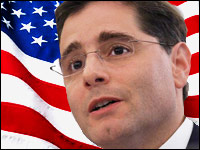
Returning to New Orleans for the first time since the Big Easy was devastated by Hurricane Katrina in 2005, the International CTIA Wireless 2012 trade show kicked off with a unified call for more spectrum.
“Like New Orleans, we are moving forward,” said Steve Largent, president and CEO of CTIA-The Wireless Association, in Tuesday’s opening keynote addresses. “As an industry, we don’t stand still. We continually reinvent ourselves. It is in our DNA. We take on complex challenges and solve them.”
The industry hasn’t stood still. Wireless subscriptions increased 7 percent in the past year, while data-capable devices saw a 9 percent increase. There are more than 295 million data-capable devices now in use in the United States. There’s been a 43 percent increase in use of smartphones, with more than 111 million pushing data usage. Mobile carriers saw a 123 percent in network traffic.
“This screams for the need for more spectrum,” said Largent. “The government needs to step in. Getting more spectrum is the No. 1 goal at CTIA.”
Spectrum, Spectrum, Spectrum
The demand for spectrum was further emphasized at the keynote, as were several solutions.
“U.S. networks are now running at 80 percent capacity,” noted FCC Chairman Julius Genachowski during his address at Tuesday’s keynote.
That said, “rumors of the spectrum demise have been greatly exaggerated,” he quipped, evoking Mark Twain’s famous quote to make the point.
The issues will be solved by large and small companies, along with government assistance, added Genachowski, further stressing that it is “better to face these challenges than see shrinking demand.”
One of the solutions could be spectrum sharing between the government and commercial networks, allowing unused bandwidth to be utilized instead of remaining vacant.
“This really is the single most important issue facing the CTIA this year,” said Jeffrey S. Silva, senior policy director of telecommunications, media and technology at Medley Global Advisors.
“The mobile industry is facing increased usage while demand continues to rise,” he told TechNewsWorld. “In the end, this is the live-or-die moment for them.”
Wireless Solutions for America
The widespread adoption of mobile was emphasized during Tuesday’s keynote. The reach of mobile phones reportedly has surpassed virtually any technology advancement to date.
“More people around the world have mobile phones than electricity or running water,” said Genachowski. “It is the most pervasive technology we’ve ever seen. And it is the fastest computing platform adopted worldwide.”
This point has been made previously, and for the developing world, the mobile phone could replace the computer and TV as the way users connect. This is also true for some of the more-isolated parts of the U.S. as well.
“For rural America, the mobile phone is very important,” Kentucky state Rep. Martha Jane King, D-Lewisburg, told TechNewsWorld. “This is an issue that is comparable to the analog-to-digital TV switchover, but in this case the government has a huge amount of spectrum.”
For those rural districts, mobile technology can open a window to the world.
“In my district in Kentucky, not a lot of fiber has been laid,” said King. “Terrain is still an issue for mobile towers, but it could finally be a way to get services that haven’t been previously available.”
Innovation and Investment
While sharing of bandwidth is one solution, another that was touted during the opening keynote was small cell technology, which would off load some of the demand to WiFi.
However, “WiFi is facing congestion as well,” noted Genachowski, adding that the U.S. needs to step up to meet the challenges through innovation, investment and competition.
“The U.S. is leading this revolution,” he said. “We have regained our leadership in mobile, and U.S. mobile innovation is the envy of the world.”





















































